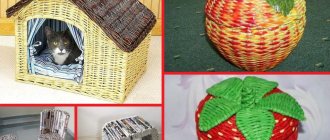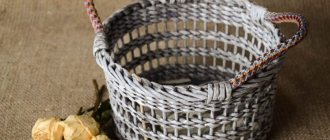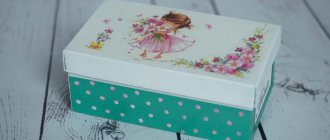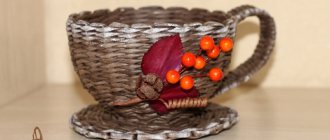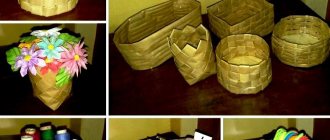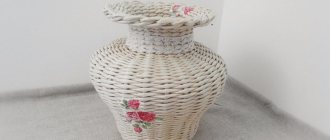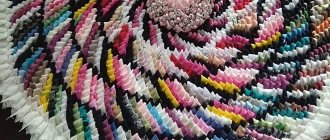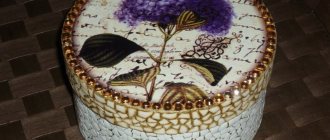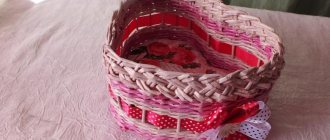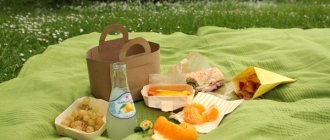Newspaper weaving is based on the example of wicker weaving. You can make many things from such material, such as vases, boxes, stands, trays, paintings and more. It is very often used in everyday life, and most importantly, the material is accessible to everyone.
In this article we will look at how to learn how to make boxes from straws yourself, thereby immersing yourself in the art of handmade. If you are wondering how to make such a box with your own hands, but don’t know how, we will help you with this.
Box of newspaper tubes
To weave a beautiful box, you will need a ready-made square bottom, tubes and wooden skewers to align the corners.
Take a mold of a suitable size, insert it into the middle and start braiding from the corner post. Use standard chintz or checkerboard weave for two working tubes. In the process, carefully level and lift all the racks, and to prevent them from breaking, moisten them in advance. To make a right angle, wrap the stand with a loop from the inner working tube and cover it with the outer one - and then continue to weave as usual.
To prevent the structure from deforming, place additional racks with skewer in the corners. Continue braiding the entire structure around the perimeter until you have the required number of rows. If the racks at the bottom were too short, they can be extended.
To add a rope pattern, finish the weaving and trim the previous working tubes. Then insert three new ones behind three adjacent posts from the corner and secure with glue. Place the first tube over two racks behind the third, the second - behind the third free rack from it, and so on.
Carefully hide all ends inside under the pattern, trim and secure with PVA. Weave the box with regular chintz weave and close the last row with a braid made from uprights. Pull and compact the row, carefully trim the ends and coat with glue again.
Secrets of mastery
In order for the product to have a finished look and look aesthetically pleasing, you need to learn how to start and finish the work correctly. Technically perform “folds”, secure fragments, make smooth transitions from horizontal to vertical planes and decorate during finishing.
Newspaper weaving for beginners will be more successful if you take the advice of “advanced” craftswomen.
Before you start binding, draw on cardboard a diagram for the bottom in the shape of a sun, where the circle is the base, and the rays are the number of knitting needles to expand it. For a “complete picture”, arrange the reeds on the sketch and secure with clothespins along the edges of the cardboard;
A smooth transition from the base to the walls is possible if you raise the first row at an angle of 30°, braid it with a “rope”, then for the next circle raise it again by 30°. By the fourth or fifth row, the contour of the product will be leveled;
If additional fragments or finishing fastening are needed, use polymer adhesive (“Titanium” or “dragon”). PVA, due to its consistency, can soak adjacent elements;
To decorate the product, you can use decorative ribbons (made of fabric or synthetic fibers) and pass them over the fabric between the gaps of the racks.
How to roll newspaper tubes
Let's start with the first and most important thing - twisting the newspaper tubes themselves. Fold the newspaper in half twice and cut into four separate pieces. The width of a standard newspaper is already ideal for rolling tubes of optimal length and thickness.
To work, take long thin knitting needles of different diameters: for example, 2 and 3 mm for thin and thick tubes, respectively. Dilute PVA glue with water in advance in a ratio of 3:1 or in any other ratio convenient for you - be guided by the consistency as you work.
Take one sheet, unfold it with the fold upward, place the knitting needle on top slightly diagonally and wrap it with a corner. Roll the paper tightly until you reach the opposite edge. Lubricate the corner with PVA glue, wrap the tube tightly to the end, pull out the knitting needle and leave to dry. To make the finished tubes bend better when weaving, moisten them with water.
What stages will you have to go through?
Step one. Fold the newspaper in half and cut it in half. Wrap one finished piece of newspaper in wire or knitting needle.
Step two. Glue the entire remaining edge of the newspaper and roll it up to the very end. To make a box you will need approximately 30 of these sticks.
Beautiful examples
Wickerwork not only decorates the interior, but also performs practical functions. Large baskets and boxes store laundry. Small ones can be used to store spices. The book box is a convenient place to store documents or jewelry.
The quality and beauty of the craft depends on the experience and skills of the craftswoman. Large wicker baskets are great for storing balls of yarn. Wicker boxes with an additional element inside are suitable for storing sewing accessories. This is a flat piece with sticks on which spools of thread are threaded.
Wickerwork in the form of original souvenirs of various shapes is good. For skilled hands it will not be difficult to weave a box in the shape of an apple, melon, or mushroom.
Heart-shaped boxes are popular. The bottom for this box is cut out in the shape of a heart from hard cardboard or plywood. Additionally, they make a decoration for it to cover the ends of the glued posts. Weave with any pattern upwards, maximally observing the shape of the heart. The lid for this box is made similarly to the bottom. Braid the workpiece in one of the ways. It is advisable to decorate a heart-shaped box with flowers, ribbons, beads and much more, which is up to the imagination of the craftswoman.
How to weave a box with your own hands, watch the video.
Paper for the bottoms or imitation wrinkled fabric/leather.
If wallpapering cardboard seems too banal or just doesn’t suit your taste, don’t be afraid to experiment! For example, use regular A4 sheets or watercolor paper.
Take a regular sheet of A4 office paper and lightly spray it on both sides with a spray bottle. Next, scrunch it into a ball, making small folds, and hold it in your fist. This is necessary so that each fold is well saturated with water and slightly loosened. Carefully unroll the wet sheet of paper and place it on the film.
Take a brush and paint the sheet on one side with a light stain. Turning it over, paint it dark.
Advice! It will be much easier to turn the sheet over without damaging its integrity if you cover it with a second piece of film, turn it the other side and remove the piece on which the paper was originally located.
A very interesting pattern appears on the front side of the paper: veins painted with dark stain appear through the light stain.
After drying, the paper will shrink slightly and begin to look like leather. Before gluing it to the cardboard, it is recommended to spray the sheet on one side with a spray bottle.
After varnishing such bottoms, they turn out unique and quite attractive.
Alena Bugrova offered her step-by-step video tutorial on decorating the bottom of a wicker basket. This method requires more effort and time and involves applying a multi-layer patina. The result will pleasantly surprise you!
Master class No. 4
You will need:
- box (either a regular cardboard box or a cigar box will do);
- corduroy or velvet fabric;
- foam rubber 1.25 cm thick (the width should be equal to the width of the foam rubber pad, and the length should be twice its length (for example, if the finished pad measures 12.5 x 12.5 cm, then you will need a piece of foam rubber measuring 12.5 x 25.5 cm));
- thin cardboard (you can, for example, use a notebook cover);
- stationery knife;
- scissors;
- ruler;
- hot glue gun.
From thin cardboard, cut a rectangle 3 mm smaller than the bottom of the box. Use a pencil to mark where the foam pad will end and cut the cardboard at that point. Take the base cardboard for the soft pad and line it (the width of the strips should be approximately 2.5 cm).
Next, take a piece of foam rubber the width of a cardboard, but twice as long as it, line it into strips 5 cm wide, then cut along the lines. Apply glue to one section of cardboard and glue the foam rubber, after folding the piece in half lengthwise. Glue the remaining pieces of foam rubber in the same way.
Take a piece of fabric equal in width to the resulting base, but much longer than it. Glue one end of the piece to the back of the cardboard, wrap and cover the foam pads, inserting the fabric into the gaps between them. Use the remaining fabric to wrap the cardboard again and glue.
Now you will need a piece of cardboard 1 cm wider than the height of the resulting pad. Bend it, stepping back 1 cm from the edge (the bent cardboard should “cover” the foam rubber). Make a “wall” for the other side of the pad in the same way.
Take two pieces of fabric (they should be 2.5 cm larger than the cardboard itself), cut off the corners and cover the cardboard. Glue the “walls” on the sides of the pad.
Cover the cardboard that you are going to glue to the remaining area of the bottom of the box with fabric. Glue both pieces to the bottom of the box and you're done!
How to choose paper
When choosing paper, you must first pay attention to the density. The thinner the sheet, the better, so newspaper is the best option
But when using it, the possibility of getting your hands dirty on the inks of the printing house cannot be ruled out.
The lid can hide the contents of the box and decorate the product.
In order for the lid to fit well on the box, it must be 1 cm larger in diameter than the box itself.
You can purchase blank consumer paper in reams. There is also the opportunity to purchase paper rolls or newspaper strips from the printing house.
The lid of the box can be decorated with pictures, photographs, bows, lace, ribbons and much more.
You can also make wickerwork from ordinary office paper. The density is almost twice that of newspaper. In this regard, the tubes are a little more difficult to twist, and fit worse during the weaving process (they break). In this case, the joints of the paper are much more visible when twisted.
You can also make a box with a hinged lid that will close with a hook or loop.
It is advisable to make the bottom out of cardboard, as this will make your work easier, but you can weave it yourself.
Reference. The density of newsprint paper is 45-50 g/m2, and office paper is around 80 g/m2.
Crafts for beginners step by step
An important detail in weaving is that the tubes for the stands need to be dry, and the working tubes need to be moistened so that they become elastic. For beginning craftswomen, a step-by-step master class on weaving boxes with and without a lid will be useful.
- The bottom for the product can be woven. But it’s easier to make it from hard cardboard, plastic or wood. Handicraft stores sell ready-made perforated bottoms. The holes in the bottom are located at a distance of 1.5-2 cm.
- Take a tube, bend it in half and insert the ends into 2 holes in the bottom. All holes are filled in this way. These tubes will be the posts around which weaving is done.
- Fold the next tube in half and place it on the stand at the bottom, folding it in a cross. The stand will be surrounded by a working tube.
- Start weaving in the simplest way, “rope”. The upper part of the working tube is inserted behind the subsequent stand from the inside, and the lower part wraps around the stand from the front side.
- When the tube ends, it is extended - the next tube with its sharp end is inserted into the previous one and lengthens the workpiece.
- The “rope” method is usually used to knit the lower part of the box, 4 rows. This will be the edging of the bottom. At this stage of weaving, a blank form (pan, teapot, etc.) is inserted into the product to support the product.
- The middle part can be woven into a more complex pattern using numerous weaving patterns. These are chintz, vintage, cross, checkerboard and many others.
- For the beauty of the product, the color of the tubes is changed, then the box will come out with a pattern.
- If you add another tube to the work and weave three of them, placing them behind every third post, you get a different pattern.
- The final stage is bending the racks at the top of the product. First, bend the posts outward. To do this, we start each rack behind the next one and lower it down. Then bend them inward through the holes, secure them there and trim off the excess. The cut ends of the stands or working tubes are glued inside with glue and secured with a clothespin.
- To draw working tubes, craftswomen use a crochet hook if the weaving is tight and the posts are located close to each other.
Popular articles Cheerful snowman made of cotton wool
Weaving a heart-shaped box
This product is much more difficult to make than an oval one, but it is doable. To do this, just find or make your own heart-shaped base.
Execution principle:
From thick paper, in this case it is cardboard, cut out a heart twice, choose the size yourself. Prepare rolled newspaper tubes right away so as not to waste time on them during the gluing process.
Using a glue stick, glue all the diameter tubes to the bottom of the box, in this case to the heart, secure and let dry for at least half an hour.
Cover the second heart with a piece of fabric on one side, secure it in the same way and connect it to the second part, let it dry. Place the box mold in the very center and start creating it. After you finish gluing all the parts, attach the already covered heart to the bottom of the product.
Options for decorating the box
Creating the product described is not an easy task, but if you still succeed, then it is recommended to move on to decorating the product.
NOTE!
Washing a down jacketWhat you can make from foamiran with your own hands: interesting ideas and photo examples of crafts
- Nutrition for pregnant women
To decorate a homemade box, you should use the following methods:
- decorate with acrylic paint;
- varnish;
- decorate with satin ribbons;
- decorate with various laces;
- attach bows, rhinestones, buttons;
- decorate using decoupage or scrapbooking.
By decorating the box and placing some nice trinket in it, you can give a gift to your friends and relatives.
Such a product will decorate almost any home, and the ability to place something in the box (jewelry, craft materials, buttons) is an additional bonus.
Step-by-step weaving instructions
Wicker crafts are made in accordance with step-by-step instructions. It is recommended to study it in advance so as not to encounter difficulties during the work.
Weaving stages
Before work, it is recommended to familiarize yourself with the stages of weaving a box. In the presented question, the following sequence of actions is distinguished:
- Preparation of materials. This stage includes not only collecting all the tools and materials for work, but also preparing the tubes. The blanks should also be painted in the desired color.
- Preparing the bottom. Weaving starts from the bottom. Several tubes are combined with each other by crossing. Then they begin to weave the tubes in a circle, forming a flat bottom of the desired shape. You can additionally add cardboard if you plan to use the finished craft for storing items.
- Weaving a box. Next, they continue to bend the base of the bottom upward. If the work is being done for the first time, a form is used. Weaving continues by analogy.
- Cover weaving. The lid is woven separately from the entire craft. It is made by analogy with the bottom. The advantage of this part is that it can be tried on to a finished box. As soon as the dimensions are suitable, you can stop working. If necessary, attach a handle to the lid.
At the end, the work is decorated in any possible way. You can attach additional beads, rhinestones, stickers and other elements.
Beginning of work
In order to get started, you must read the instructions “how to make a box with your own hands” and understand the technique. The most common method is simple weaving, which is ideal for beginners.
Rope weaving is often used to create boxes. The whole point is that the tubes should be threaded through each other to achieve density.
If you want to create a stand for a mug, then plain weaving is suitable for you. Spiral weaving is used to create paintings and other decorative items. To make the fake look more beautiful, it is decorated with drawings.
Weaving methods
The most popular are boxes with a round bottom, so a step-by-step master class on how to create them will be given below.
For a round box we will need about 230 tubes. To make them, you need to cut each newspaper into strips about five centimeters wide. This can be done using a utility knife, folding the newspapers into a neat stack, or you can cut each one with scissors. Choose a method more convenient for you. If the box is light in color, it is best to use newspaper or other thin paper, since the letters of the printed product will show through the paint.
- acrylic primer (0.5 l), mixed with two spoons of color - this paint makes the tubes more elastic and easier to work with;
- water (0.5 l), mixed with two tablespoons of color and a tablespoon of acrylic varnish;
- fabric dye diluted in hot water with the addition of table salt and acetic acid - when dyeing in this way, the tubes will not break during weaving, and your hands will remain clean;
- food coloring, diluted according to instructions;
- water stain - for uniform coloring and to prevent brittleness, it is better to add a little primer to the stain;
- any water-based paints.
- You need to cut out a circle of the required diameter from cardboard. Glue 16 tube-rays along the edges at equal distances from each other, evenly diverging in different directions, and start weaving from step 6.
- It is necessary to arrange eight tubes in pairs so that they intersect in the center (in the form of a snowflake). Let's call these paired tubes rays.
- 5. Place a new newspaper tube under the central part of the craft and wrap it around pairs of rays in turn (in a circle), increasing it as necessary, as indicated earlier.
- 6. When seven circles are woven, the rays must be separated from each other so that there are sixteen of them. Just like at the beginning of weaving, place another paper tube down and continue weaving in a circle with a “rope”. To do this, the first ray must be wrapped in newspaper tubes at the same time from above and below. When braiding the second ray, you need to change the position of the newspaper tubes: the one that was below will now wrap around the ray from above and vice versa. Using this algorithm, continue working in a circle.
- 7. When the diameter of the bottom corresponds to the intended size, the working tubes need to be glued with PVA glue and secured with clothespins. And, after waiting for complete drying, remove the clothespins and cut off the working tubes.
- 8. To continue weaving the craft, you need to raise the rays up (we will call them risers below). If they are short, build them up. Each riser must be laid underneath the nearby one and bent upward. Thus, all 16 standing rays must be raised up.
- 9. To make the box even, it is advisable to place some form on the finished bottom: a vase, a salad bowl, a plastic bucket, a cylindrical cardboard box, etc.
- 10. Place a new working tube between the mold wall and the riser. Repeat this next to the second riser, taking another tube.
- 11. Next weave with a “rope” to the very top of the box. Weaving with a “rope” is described in paragraph 6. If the box has a pattern, then you need to weave tubes of the color indicated in your diagram.
- 12. Having finished the work, the tubes need to be glued, then the unnecessary long ends should be cut off.
- 13. The remaining standing rays must be bent. To do this, lead the first one behind the second one and go around it, the second one goes around the third one, and so on until the end.
- 14. After going around, a hole appeared near each riser. You need to thread the ends of the risers through them, glue them on the inside and cut them off.
- 15. Using the same principle, weave a lid, not forgetting to take into account that its diameter should be slightly larger than the box itself (about 1 centimeter).
- 16. To increase wear resistance, moisture protection, and add gloss, the finished product can be varnished.
The box with lid can be decorated according to your preferences. You can glue rhinestones, beads, lace; perform decor in the style of “decoupage”, “scrapbooking”. In the finished product you can store light small things: accessories for needlework (beads, buttons, seed beads, etc.), hairpins, jewelry, receipts, etc. Or you can simply use such a box as decoration, making it so that it fits according to the style to your interior.
Watch the video below for a master class on weaving a box from newspaper tubes.
Fruit basket
Finding practical uses for things you make yourself is always easy. For example, it would be a good idea to make a fruit basket: the product can be used instead of a metal fruit bowl and you can put light fruits inside. Some finished baskets can hold a lot of weight, everything will depend on the technique and density of the weaving.
Can store fruits
To make a beautiful fruit basket yourself, prepare 310 pieces of newspaper tubes - their length is 27 cm. It is recommended to pre-paint the tubes with the following composition: take 2 tbsp for half a liter of water. l. acrylic varnish and mix with the shade color. Process all the tubes and begin step-by-step work.
| Stage | Description |
| Bottom formation | The bottom is made using rope technique using a cross for the base. Take 12 tubes, divide them into groups of 3 each and glue the cross. |
| Weaving bottom | Weave 6 rows using this technique, braiding 3 tubes at a time, and then begin braiding 1 bundle at a time. So it is necessary to weave until the bottom of the desired diameter is obtained. |
| Forming the sides | To make rises for weaving the sides of the structure, you need to insert 3 more tubes into each hole with a stick. |
| Weaving of sides | By placing the bottom on a round object, such as a wooden bowl, you can continue working. Here you can already weave boards using the layer-by-layer technique: it is done in 2-4 rods and will be much more reliable than the rope method. |
| Creating openwork | To make the basket elegant, you can create a pattern: in the center of the weaving, simply cross the adjacent rods, imitating rhombuses. Press each connection with a clothespin and weave in new rods for further work. |
| Handle Formation | When the main work is ready, we begin to create a handle: we insert additional rods from the sides of the product and create a handle, according to the master class indicated above. |
| Decor | We finish the structure as we wish: we paint it with multi-colored pigments and make fabric inserts. |
Fruit basket
Detailed master class
This basket does not need a lid, because it is intended for storing fruit. The handle of the product can be effectively decorated with a rose made of foamiran.
Round box with lid
Cut out two circles from thick cardboard, coat them with glue and cover them with newspaper or any other beautiful paper. To carefully wrap the edges in a circle, make cuts along them. If you wish, you can immediately paint and dry the workpieces well.
Popular articles Luxury picture frameUsing double-sided tape along the entire diameter, place stand tubes, the number of which must be calculated in advance. Fill everything with glue around the perimeter, place the second bottom piece on top and dry it under pressure. To start weaving, insert a working tube next to the stand or connect two and loop it on.
Braid the entire base around the perimeter with two tubes of a spikelet, pressing tightly. Moisten it a little, bend the racks, and lift them up on the next lap. To make the box more interesting, add a second working tube of a different color.
Build up all the details so that these places are hidden on the wrong side. And so that when weaving the box itself holds its shape, use a blank of a suitable size. You can braid any round box of the same diameter. Weave the last row, bending the racks inwards as much as possible parallel to the bottom.
Then carefully bend each post one after the other and cut it to the same length. Lift them back and braid them again with two long working tubes, just like the sides before. After three rows, cut all the posts as close to the edge as possible and tint the ends.
Make a beautiful decorative cover from cardboard, wrapping paper or napkins. Glue the posts into it in the same way as into the bottom, and use the same principle to weave a small lid. Calculate the number of rows during the process, based on your box.
How to make, twist newspaper tubes from newspapers and paint?
We twist tubes from newspapers
For those needlewomen who are taking on the process of twisting newspaper tubes for the first time, this task may seem very difficult and almost impossible. But over time, once you get the hang of it, you can achieve pretty good results when the newspapers seem to roll up into tubes themselves.
So, here is a list of materials needed for rolling newspaper tubes:
- Newspapers
- PVA glue or stationery glue stick
- Knife, stationery knife or scissors (whichever is more convenient)
- Thin knitting needle 0.5-1 mm or skewer
Materials needed for rolling newspaper tubes
Algorithm for rolling newspapers into tubes:
- Take a newspaper or a stack of newspapers.
- We fold all the pages so that they lie clearly under each other.
- Fold the newspaper in half.
- Again, make sure that the edges of the newspaper do not extend beyond each other.
- Cut the folded newspaper in half.
- We fold the resulting halves of the newspaper in half again.
- Cut the newspaper halves along the new fold.
- We sort the resulting newspaper quarters into two piles.
- We put strips of newspaper with white edges into one pile - the tubes twisted from them will be pure white.
- In another pile we put the strips with letters - the tubes twisted from them will be with a seal.
- We take one of the newspaper strips.
- We place the knitting needle in its lower right corner.
- The knitting needle is placed at an angle of 25-30 degrees.
- Holding the tip of the newspaper, we begin to twist the knitting needle, winding the paper around it.
- We try to roll the newspaper as tightly as possible.
- Having twisted almost the entire tube, coat its edge with glue and glue it to the tube.
- We take out the knitting needle.
- Allow the finished tube to dry for 15-20 minutes.
How to twist tubes from newspapers?
It is worth paying attention to the fact that the final version of the finished tube will have two ends of different thicknesses - on one side the tube will be thicker and on the other thinner. This structure of the tubes is necessary in order to “build up” them
“Extension” is a procedure based on the creation of long tubes. It consists in the fact that the thinner end of another tube is “screwed” into the thicker end of one tube and “glued” into place. This way you get one long newspaper tube.
What do we need to make a box?
- Newspaper
- Scissors, pencil
- Glue (PVA or pencil)
- Wire or knitting needle
- Acrylic paint, gouache, watercolor
Necessary tools for creating a casket
Before you start making the casket, you need to prepare the basic tools. Below is a list of what must be at hand, since sometimes during the work there is no time to be distracted by searching for available tools.
- Scissors
- Paper
- Clear adhesive tape
- Glue
- Ruler
- Pencil
- Eraser
- Penknife
Materials for decorating the chest:
- rhinestones,
- clothespins,
- laces,
- ice cream sticks,
- threads,
- postcards, etc.
Regarding the last point, you can look for materials for decoration after the casket is ready, since it will take some time for the glue to dry well.
Also, if necessary, you can add to the above list, because making crafts is a purely individual process and each person’s imagination works differently, so other improvised means can be added.
Materials and tools
Paper. Let's go to the paper vine harvesting! What is the best material to make tubes for weaving from? First of all, from old newspapers. Newsprint paper is thin, curls well, and absorbs paint well. Low density A4 paper (60–65 g/m2) is also suitable. It is called “newspaper” or “consumer”, “writing”.
In addition, you can use magazines, old notebooks, cash register tape, etc. to make straws.
How to cut paper Paper is a fibrous material, and, like fabric, it has a longitudinal and transverse direction of fibers. Typically, small-format newspapers (57x40 cm) have fibers along the long side, and large-format newspapers (84x57 cm) have fibers along the short side. In A4 paper, the fibers often run along the long side, but sometimes you come across paper cut crosswise by manufacturers. Before cutting the entire pack into strips, check the curl of the material on one of the sheets. Place the sheet on a damp surface - it will begin to roll itself into a roll in the longitudinal direction. This is the direction you need to cut.
Glue. To work with newspaper tubes, you can choose any glue suitable for paper. For example, PVA or glue stick
It is important that it has good fixing properties, otherwise your tubes may unwind during painting
Density also matters. If the glue is too liquid, the tubes will get wet during extension.
Water-based wood stains will help you paint paper straws in the colors of pine, maple, oak, rosewood and even ebony wood. You can find about two dozen shades on sale. There is a powdered stain that is diluted with water before use.
A mixture of construction primer and color is also very suitable for painting tubes. Before use, be sure to dilute the primer with water, as indicated in the instructions on the bottle. Keep in mind that paper is a highly absorbent surface.
How else to color the tubes To give the tubes the desired color, you can use dyes for wool, fabric, printer, food coloring, hot decoction of onion peels, brilliant green and potassium permanganate.
Varnish. To make your work durable and not afraid of dampness, it needs to be varnished. Any wood varnish will do, but indoors it is best to use acrylic. It is odorless, after application it dries quickly and becomes transparent, forming a protective film.
Knitting needles and skewers. To twist paper strips into tubes, you will need knitting needles of different diameters - from 1.5 to 4.5 mm - or wooden skewers for kebab. Tubes twisted on a thin knitting needle look most like a vine. They are dense and almost do not wrinkle during weaving. And on a thick knitting needle you get tubes that are easy to flatten. And if they are twisted from very thin paper, then they can be woven like straw.
Scissors or knife. You will need one of these tools to cut newspapers into strips. But twisted tubes are best cut with pliers.
A spray bottle is needed to moisten dry tubes: sprinkle them with water and put them in a plastic bag. They will become flexible and obedient again. The spray bottle can also be used to apply paint to crafts.
Brushes are used to paint finished crafts and - sometimes - tubes. You will need wide and thin brushes.
Clothespins secure the tubes, prevent the weaving from unraveling and make gluing the parts easier.
Holes are made with an awl, the rows of weaving are moved apart, and tubes are pulled between them.
Features of weaving various boxes
First, you need to decide on the shape of the future box. It can be round, square, oval, rectangular, or leaf-shaped. Beginners are recommended to use a ready-made template to work with.
A round box can weave around a jar or pan. A square or rectangular craft can be woven around a box of a suitable shape. Small crafts are used to store threads and other small items. You can make them based on a glass or mug.
Weaving a rectangular box
The rectangular shape of the box is rarely chosen for the first experiment. But it is easier to make only because you can use cardboard to form the bottom.
This requires:
- Cut the cardboard to the required size and glue the newspaper tube bases to it.
- Next, bend the bases up and begin weaving according to the shape. To do this, just take any shoe box.
- Finish the work by reaching the desired height of the box.
Detailed instructions and operation diagram are presented in the video.
Casket with lid
A box with a lid can be made by analogy with the instructions presented above. First you need to weave the base - a container of the desired shape, and only then proceed to making the lid. Depending on the shape of the craft, they determine how the lid will be made. If it is a square box, the top can be woven in the same way as the bottom - using cardboard as a base.
Square box
A square box can be woven similarly to a rectangular one. To do this, they also make the bottom out of cardboard, and then move on to weaving the walls. If necessary, a lid is made so that storing things is ethically attractive from the outside.
How to weave an oval box
To make an oval shape, it is also recommended to use a base. You can take it ready-made or make it yourself - you can use cardboard.
The complexity and peculiarities of manufacturing lie in the formation of the bottom. It is this that will determine the subsequent work. For it, the tubes should be connected to each other - only 2-3 pieces are used for the longitudinal part, and from 5 pieces for the transverse part. Next, the making of the craft occurs in the sequence presented in the video.
Round box
We recommend that beginners pay attention to round-shaped crafts. This is the simplest weaving, since the difficulty lies only in creating the bottom
To avoid problems with the presented question, it is recommended to watch a master class on making crafts.
Heart shaped box
Experienced craftswomen can take on complex shapes of boxes. One of the most popular is the heart. It’s easy to make – just use cardboard for the base, from which you cut out a blank of the desired shape. It can be not only a heart, but a leaf, a flower, etc.
Tubes are also glued onto the cardboard base as a basis for weaving, after which they are bent and work continues, forming the walls. If necessary, weave a lid.
Popular articles Cheerful snowman made of cotton wool
Features of paper curling
Only at first glance, “twisting” is performed quickly and easily. Practice shows that you can master the technique taking into account several features.
- We cut strips of the same size from the press spreads in an approximate ratio of 1X3. To increase productivity, fold the paper into a stack and use a utility knife;
- hold the tool at an angle of 45° and tightly wind the tapes onto it. If you wind the paper at an angle of 30°, you will get a thick stick (it will be useful for “knitting needles”). And at 90° the stick will turn out to be very thin (it is used for edging);
- We fix the tail-kerchief with glue, and then remove the workpiece.
During the twisting process, they are spliced together by inserting the thin end coated with glue from one tube into the wide hollow hole of the other.
Place the finished “twigs” on a flat, hard surface and roll them with a rolling pin. Look at the master class in the photo.
Decorative balls
To make openwork balls for a garland or decoration, take colored tubes from newspaper, pre-painted with acrylic. Place them on a flat surface and roll them well with a rolling pin so that they are flat. Stay a little short of the edges to build up the tubes as you go.
To make the balloons the same, make blanks from balloons. Start wrapping the first piece with a flat tube and glue the joints with PVA or wood glue. The main thing is to make the base frame even, because the balls can become deformed in the process.
First, make meridians for further winding - like tangerine slices. Then use the free end to walk around the ball in a circle, covering all connections and joints. In the process, hide the first tip, and then tuck the last one under other layers.
Do not overuse the number of tubes so that the ball is not too rough and massive. When the blanks are dry, carefully pierce and pull out the balloon, straighten the shape and leave them to dry completely. At the end, prime the balls in a bucket with primer, dry and clean with a dry brush to remove any smudges.
https://youtube.com/watch?v=eK2YGAu7jMc
Best answers
Maria Klimova:
I remember in the early 90s there were problems with cigarettes and tobacco, our men smoked tea and brooms :) True, true. They made tubes out of newspaper (they wrapped pieces of newspaper around a pencil, then removed them from the pencil to form a neat tube), filled them with tea and smoked. And the brooms were like this: they broke off the stem from the handle of the broom, set it on fire and smoked it like a cigarette. I don’t know how it feels, I haven’t tried it.
1 `:
I remember I made it out of toilet paper, it turned out great,... it smells like some kind of dope, you don’t get high, but your head sticks out in a special way... It's better to drink it.
}{PO”:
well, respect, smoking, well, probably like everyone else
Andrey Mikhailov:
Better not, you'll suffocate
Anastasia Morozova:
You can, but don’t take long puffs, otherwise your throat will be sore, it sticks out funny
Rectangular tube bottom
Any basket, stand or box starts with a solid bottom, so first let’s figure out how to make it. And at the same time you will master the basic weaving technique, which will be useful in the future. To make it more convenient at first, make a blank with markings according to the dimensions of the bottom and add a centimeter along the edges. Lay the tubes vertically along the marking lines, and put two at the edges - they will come in handy later. If you have a large bottom, you can increase the number and thickness of the parts. To prevent anything from moving during work, secure everything with masking tape.
Along the horizontal markings just below the line, start weaving a horizontal tube. Weave each subsequent tube in a checkerboard pattern, as when darning - this is calico weaving. Make sure that the very first piece is level, because at first they move easily.
So that the protruding edges for the walls remain only according to the markings, the main mass of the whip is in one long tube, wrapping it with a snake. When it ends, increase it by carefully threading one into the other using PVA. You can carefully trim all the excess edges and add a little glue to make it secure.
When you finish the bottom, braid the entire rectangle with a kind of up-and-down braid. Essentially, this is the same weaving, but in a different plane and perspective. On the second circle, form corners with vertical posts - this is why the side tubes should be double.
About priming and painting
The finished basket must be primed in several layers with waterproof paint or PVA glue, which will have to be diluted a little with water. It should be applied with a brush with dense bristles. After priming, the product must dry, then only the outer side is painted. The paint is also applied several times, the basket is dried again, and then varnished.
Painting wickerwork
Tinting blanks
Many needlewomen use pages of colored glossy magazines instead of newspapers, then the basket acquires its charm, like a patchwork quilt, and resembles an ethnic style.
Box made of newspaper tubes - master class
The main 18 newspaper or magazine tubes are selected, divided into bundles of three pieces each and folded into a rectangular lattice.
Next, each bundle of the lattice is braided with a working vine, bent in half. The next two rows are woven, pushing the main tubes apart. The weaving is placed tightly to each previous row. The bottom is made in 11 rows of figure eight binding.
To move on to weaving the walls of the box, all the main tubes are bent at right angles, and the work continues with the same simple binding.
Having completed 13 rows, the excess ends are torn off, and the last turn is glued to the top row. The work is completed by folding the main vine behind each other in the opposite direction relative to the weaving. The entire top is smeared with PVA glue, dried, then the protruding remains of the vine are cut off.
An oval is cut out of cardboard; it should be slightly smaller than the bottom area. The same oval circle is cut out of thick paper, in this case from a piece of building wallpaper. 11 tubes of the same color are selected and cut in half; this length will be sufficient for this model.
The cardboard blank is covered with double-sided tape, then the top sticky layer is opened, on which short tubes in the amount of 22 pieces are evenly laid out. The structure is covered with a second oval circle on top and pressed for a few seconds.
Now the weaving of the lid begins. Using a working thread, folded in half, each main stick is intertwined until the desired size is reached; for this cover, 6 rows of weaving are made. The tips of the working vine are attached to the last turn, and the main rods are bent and threaded through the entire weaving area at an oblique angle onto the inside of the lid. In this process, the angle of inclination of the rods must not be disturbed so that the pattern is symmetrical.
Having pulled out all the main tubes from the inside, they are twisted behind each other. This weaving is done twice, resulting in a side. The finished element is thickly coated with PVA glue and after drying, all excess ends are cut off.
The wicker box is painted with oak-colored wood varnish and left to dry for a day.
Next, the box made of newspaper tubes is decorated with lace ribbons; the ribbon is glued to the inside with “cosmofen” universal glue. On the surface of the lid, the lace is gathered and also glued. Leaves are cut out of green satin ribbon, the edges are burned over a match flame. Flowers are twisted from a pink ribbon and fastened with a thread and a needle. The finished decoration is glued with universal glue in any desired order.
The box of newspaper tubes is ready.
How to paint tubes
To select a decorative coating, it is necessary to take into account the properties of paints. Watercolor and gouache paints are recommended to be used to cover blanks. Watercolors tend to fade after application, while gouache has bright shades, but also needs to be diluted with water.
It is easy to store any small item in such a box, and it can also be used instead of a candy box or key holder.
Acrylic is used for the finished product; wood varnish can also be used. Acrylic gives gloss, and varnish gives the product durability and the effect of a real vine.
Photos of beautiful products made by skilled needlewomen will allow you to be inspired to create your own box from newspaper tubes.
The use of homemade boxes
A box in the house for a woman is a very useful thing, and for a needlewoman it is simply necessary. Moreover, the more of them, the better: in one there are embroidery threads, in the second - balls, in the third - knitting needles, hooks and needles, in the next - ribbons and braid. And somewhere else you need to put scissors, glue, a stationery knife, stencil staplers... The more hobbies you have, the more boxes, chests and boxes you need.
Small boxes are suitable for small items, and a large box can be intended for laundry prepared for washing.
In addition to the fact that the box is a necessary thing in the house, it is also a wonderful gift: as an independent gift or as a box for the main gift. A wide variety of design options will make it, depending on the occasion, spectacular and original, festive and discreet.
